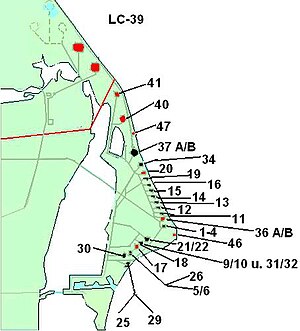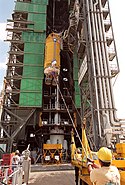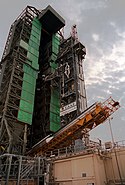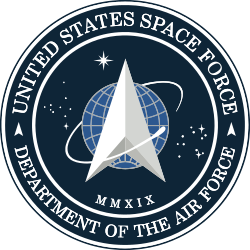Launch Complex 36
| Launch Complex 36 | |
|---|---|
 Atlas-Centaur mit Mariner 10 auf Pad 36B | |
| Koordinaten | 28° 28′ 11″ N, 80° 32′ 22″ W |
| Typ | Orbital Launch Site |
| Betreiber | |
| Baubeginn | 1961 (36A) / 1963 (36B) |
| Launch Pads | 2 (36A, 36B) |
| Raketen | Atlas, New Glenn (geplant) |
| Erster Start | 9. Mai 1962 |
| Letzter Start | 3. Februar 2005 (NOSS 3) |
| Starts insgesamt | 145 |
| Status | im Umbau |
Der Launch Complex 36 (LC-36, von 1997 bis 2010 als Space Launch Complex 36, SLC-36 bezeichnet) ist ein inaktiver Raketenstartplatz auf dem Gelände der Cape Canaveral Space Force Station auf Merritt Island, Cape Canaveral in Florida, USA. Er bestand aus den beiden Startrampen 36A und 36B und wird derzeit für Starts der Großrakete New Glenn komplett umgebaut.
LC-36 war für die Erforschung des Sonnensystems von großer Bedeutung: Surveyor-, Mariner- und Pioneer-Raumsonden starteten von hier.
Geschichte
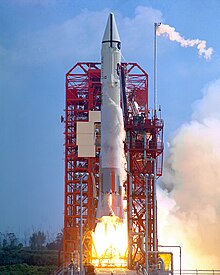
Die Bauarbeiten für den Launch Complex 36 begannen im Februar 1961. Damals wurde zunächst nur Pad A gebaut. Es dauerte noch einige Jahre, bis schließlich Anfang 1963 Pad B gebaut wurde.
Bis Ende 1989 waren die Rampen unter Führung der NASA. In dieser Zeit starteten vom Komplex wesentliche Forschungsmissionen: Nach einigen Tests mit Surveyor-Modellen startete am 30. Mai 1966 Surveyor 1, gefolgt von den weiteren Sonden dieser Reihe. Zwischen Februar 1969 und November 1973 wurden die Mariner-Missionen 6 bis 10 ins All gestartet. Als Nächstes startete man eine Reihe Intelsat-Satelliten und Pioneer 10, 11 und die beiden Pioneer-Venus-Sonden.
Danach übergab die NASA die Rampen an die US Air Force und General Dynamics, die sie für militärische und kommerzielle Projekte nutzten. Die erste kommerzielle Rakete startete am 7. Dezember 1991, der erste Militärsatellit am 11. Februar 1992.
Die Starts von SLC-36 wurden im Oktober 2005 eingestellt und am 16. Juni 2007 wurden beide Startrampen mit 55 kg Dynamit gesprengt.[1][2]
Im August 2008 gab Space Florida, eine bundesstaatliche Organisation zur Förderung der Raumfahrt in Florida, bekannt, dass sie mit der USAF einen Vertrag abgeschlossen hat, um SLC-36 umzubauen und kommerziell zu vermarkten.[3]
Im September 2015 mietete das US-Raumfahrtunternehmen Blue Origin die Einrichtung. Es ließ die alten Atlas-Startanlagen abreißen und baut derzeit eine neue Startvorrichtung für New-Glenn-Raketen. Die NASA als Kunde des ersten New-Glenn-Flugs hält einen Start im August 2024[veraltet] für möglich.[4] Blue Origin plant sowohl unbemannte als auch bemannte Missionen.
Der Komplex
LC-36 bestand aus zwei sehr ähnlichen Startrampen: Es gab einen mobilen Serviceturm (Mobile Service Tower (MST)) und einen kleinerenHilfsturm (Umbilical Tower (UT)), der die Atlas-Rakete bis kurz vor dem Start versorgte und nicht beweglich war. Die Türme waren 56,38 m bzw. 63,7 m hoch.
Wie viele Servicetower besaß der MST einen Kran, mit dem die Oberstufe und Nutzlast montiert werden konnte. Die erste Stufe wurde jedoch mit Seilen, die nicht am Kran befestigt waren, verbunden und samt dem Anhänger des LKWs aufgestellt.
Der Kontrollbunker deutete noch nach der Jahrtausendwende darauf hin, dass die Türme vor einigen Jahrzehnten gebaut wurden: Er ist bräunlich mit abgerundeten Dach und befindet sich sehr nah an den Rampen.
Startliste
Zusammenbau einer Atlas auf LC-36
Weblinks
- Cape Canaveral LC36A und LC36B in der Encyclopedia Astronautica (englisch)
- LC-36 in der CCAFS-Tour (englisch)
Einzelnachweise
- ↑ Complex 36 mobile service towers brought down, spaceflightnow.com (englisch)
- ↑ Former Atlas launch towers knocked down at Complex 36, spaceflightnow.com (englisch)
- ↑ U.S. Air Force to license Launch Complex 36 to Space Florida, Pressemeldung von Space Florida (englisch)
- ↑ Jeff Foust: NASA Mars smallsat mission to be on first New Glenn launch. Space News, 21. November 2023, abgerufen am 30. November 2023 (englisch): „His charts, though, and past presentations, listed an August 2024 launch for ESCAPADE.“
Auf dieser Seite verwendete Medien
A blue dot only / Nur ein blauer Punkt
The GOES-L satellite is about midway in its journey up the gantry on pad 36A, Cape Canaveral Air Force Station. The Atlas IIA rocket is designed to launch payloads into low earth orbit, geosynchronous transfer orbit or geosynchronous orbit. The rocket is the launch vehicle for the GOES-L satellite, part of the NOAA National Weather Service system in weather imagery and atmospheric sounding information. The primary objective of the GOES-L is to provide a full capability satellite in an on-orbit storage condition, to assure NOAA continuity in services from a two-satellite constellation. Launch services are being provided by the 45th Space Wing. Launch is scheduled for May 3.
The Atlas-Centaur 10, carrying the Surveyor 1 spacecraft, lifting off from Pad 36A. The Surveyor 1 mission scouted the lunar surface for future Apollo manned lunar landing sites.
At Launch Pad 36A, Cape Canaveral Air Force Station, workers guide the ascent of a Centaur rocket up the launch tower where it will be mated with the lower stage Atlas IIA rocket already in the tower. The Lockheed-built Atlas IIA/Centaur rocket will launch the latest Tracking and Data Relay Satellite (TDRS) June 29 from CCAFS. The TDRS is one of three (labeled H, I and J) being built in the Hughes Space and Communications Company Integrated Satellite Factory in El Segundo, Calif. The new satellites will augment the TDRS system's existing S- and Ku-band frequencies by adding Ka-band capability. TDRS will serve as the sole means of continuous, high-data-rate communication with the space shuttle, with the International Space Station upon its completion, and with dozens of unmanned scientific satellites in low earth orbit.
At Launch Pad 36A on the Cape Canaveral Air Station, the first stage of a Lockheed Martin Atlas II rocket is lifted into an upright position. The rocket will be used to launch the Geostationary Operational Environmental Satellite-L (GOES-L). GOES-L is the latest in the current series of advanced geostationary weather satellites in service. Once in orbit, it will become GOES-11 and function as an on-orbit spare to be activated when one of the operational satellites needs to be replaced. Launch is scheduled for Saturday, May 15 at the opening of a launch window which extends from 2:23 to 4:41 a.m. EDT.
Seal of the United States Space Force.
Eine zweite Karte des CCAFS, die zum Anklicken gedacht ist
At Launch Pad 36A on the Cape Canaveral Air Station, the first stage of a Lockheed Martin Atlas II rocket is lifted into an upright position. The rocket will be used to launch the Geostationary Operational Environmental Satellite-L (GOES-L). GOES-L is the latest in the current series of advanced geostationary weather satellites in service. Once in orbit, it will become GOES-11 and function as an on-orbit spare to be activated when one of the operational satellites needs to be replaced. Launch is scheduled for Saturday, May 15 at the opening of a launch window which extends from 2:23 to 4:41 a.m. EDT.
